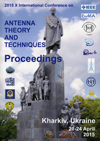Time domain analysis of transient radiation of dipole in dielectric sphere
DOI:
https://doi.org/10.1109/ICATT.2015.7136787Keywords:
time domain, UWB, pulse antenna, small antenna, propagation operatorAbstract
Transient radiation of a dipole corresponds to excitation of a spherical harmonic wave in some conical line from an evanescent wave domain. The governing equation contains a cut-off frequency that depends on radius. Using high refraction index material the cut-off frequencies for the radiating mode can be significantly reduced. This can lead to “tunneling” energy from the evanescent region and consequently increasing radiation efficiency. Of course, the effect can be straightforwardly treated in the frequency domain but of great interest is its description in the time domain, for example as a convolution operator that relates a waveform of a dipole in a dielectric sphere with that of a dipole that would create the same radiated wave being placed in a free space. This problem is solved and analyzed.References
CHU, L.J. Physical Limitations on Omni-Directional Antennas. J. Appl. Phys., 1948, v.9, p.1163-1175, doi: http://dx.doi.org/10.1063/1.1715038.
MCLEAN, J.S. A Re-Examination of the Fundamental Limits on the Radiation Q of Electrically Small Antennas. IEEE Trans. Antennas Propag., 1996, v.44, n.5, p.672-676, doi: http://dx.doi.org/10.1109/8.496253.
LUK, K.M.; LEUNG, K.W. Dielectric Resonator Antennas. Research Studies. London: Press LTD, 2003.
SHLIVINSKI, A.; HEYMAN, E.; KASTNER, R. Antenna Characterization in the Time Domain. IEEE Trans. Antennas Propag., 1997, v.45, n.7, p.1140-1149, doi: http://dx.doi.org/10.1109/8.596907.
SCHANTZ, H. The Art and Science of Ultrawideband Antennas. Artech House, 2005.

